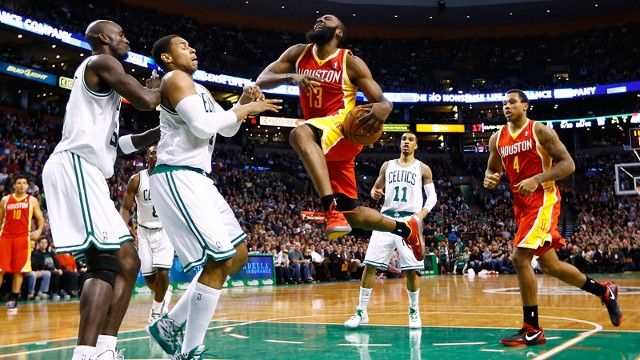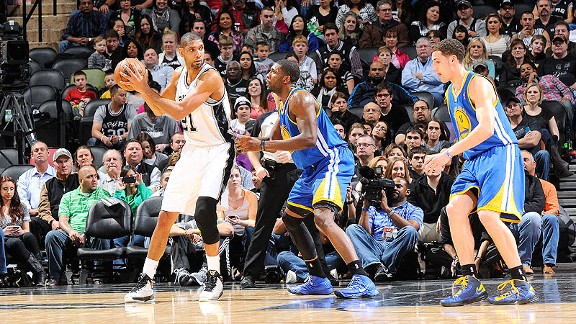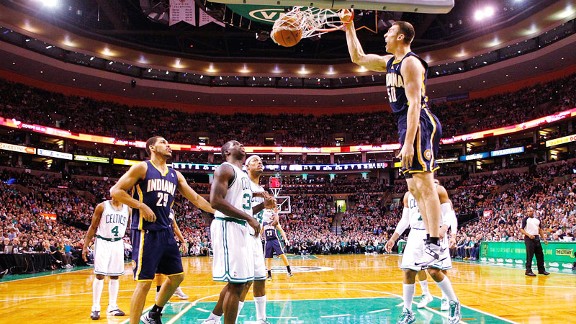
Fifteen of the league’s 30 teams have purchased a data-tracking camera system from STATS LLC that records every single movement on the court — the ball, the players, the referees, etc. — in three dimensions. The cameras can measure just about anything, and the teams that are using them best have moved far ahead in developing their own algorithms to measure whatever they wish — which team forces pick-and-rolls left most often, where corner 3s typically rebound when they miss, and how often a player accelerates from “jog” to “sprint” during a game.
(These are the subscribing teams: Houston, Boston, New York, Washington, Milwaukee, San Antonio, Oklahoma City, Golden State, Philadelphia, Phoenix, Orlando, Dallas, Minnesota, Toronto, Cleveland.)
Teams hoard their own data like kids hoard candy on Halloween. But STATS was kind enough to send Grantland a giant pile of exclusive information from the 2012-13 season, updated after Wednesday’s slate of 13 games, on a few general categories STATS tracks for all subscribing teams. The data focuses on both the player and team level, including drives to the basket, post touches, and touches at the elbow areas. From that pile, here are some Friday nuggets for your perusal:
Holy Cow, James Harden
The Rockets average a league-high 29 drives per game, with STATS defining “drive” as any time a player dribbles the ball from at least 20 feet away from the basket into an area within 10 feet of the rim. Drives do not include fast breaks, meaning transition chances don’t inflate the insane numbers Houston and Denver are putting up.
The average team “drives” about 20 times per game, and the STATS numbers show teams generally score more efficiently on any possession in which a qualifying drive happens at any moment than they do in general.
Harden averages nine drives per game, which is fifth among players whose teams have the cameras. The top four: Tony Parker (10.8), Rajon Rondo (10.1), Russell Westbrook (9.3), and Jrue Holiday (9.2). As an aside, that Holiday number is a fantastically good sign for Philly. He ranked below average by this metric last season, and he’s piling up about twice as many drives per game this season, according to the 2011-12 data I’ve reviewed. Philly is still below average as a team in drives per game, which tells you how much heavy lifting Holiday is doing for a very limited bunch.
Back to Harden: Houston is scoring 1.51 points per possession on trips in which he drives at any time in the shot clock. That is easily the highest mark among all players in the 15-team database with more than a token number of drives. It is a mammoth number; keep in mind, teams average just about one point per possession overall. Harden has drawn a foul on one-third of his drives, which is among the highest numbers in the data set, and sort of amazing when you think about it.
Jeremy Lin is averaging 8.1 drives per game, ninth among all players, and even though he’s having a disappointing season, the Rockets are scoring 1.32 points per possession when Lin drives — about what the Spurs have scored on Parker drive possessions.
In other words: There is some merit to the idea of telling guys, “Put your head down, get to the paint, and make a play — any damn play,” especially if the team has skilled 3-point shooters and good passers driving the ball. The punishment will likely be a lot of turnovers, and Carlos Delfino, more empowered to drive in Houston than he might be elsewhere, indeed ranks among the most turnover-prone drivers so far.
And what of Harden? He has turned over the ball on just 4 percent of his drives, one of the lowest numbers in the data set. The dude is scary. These numbers paint him as even more valuable than we might think.
Denver is third in drives per game, though the cameras have recorded only 11 of their games (not including Thursday night’s destruction of Chicago). The Nuggets led the league in this category last season, and they are once again among the league’s half-dozen best offenses.
Of course, you have to have players and smarts to succeed doing anything. The Kings, Cavaliers, and Bobcats rank among the most prolific driving teams, and none of them can score. The Knicks and Warriors are bottom-10 teams and rank among the league’s best offenses.
Holy Cow, Kevin Durant and Russell Westbrook
OK, so, you knew these guys were good. But Durant especially has gotten to the point where he can score at elite levels in almost every way imaginable. Drives? He’s racking up 4.8 per game, more than Kyle Lowry, Andre Miller, Paul Pierce, Carmelo Anthony, and Steve Nash, and Durant ranks among the 10 most efficient camera players in both points per drive when he finishes the play and points per drive overall for his team. He draws fouls almost as exactly as often as Harden when he drives.
Post-ups? Durant is 26-of-37 from the floor when he catches a pass within 12 feet of the rim, which is the current STATS definition of “post touch.” The Thunder average nearly 1.6 points per possession when this happens, a top-10 mark among camera players, and a stat that makes you think Durant should get more than the paltry 1.27 such touches he averages per game.
That’s the thing about Durant: Scroll through these categories one by one, and you'll say to yourself, “He should be doing this particular thing more often!” Then you realize you’ve said that for every category — drives, post-ups, elbow touches — and you just shake your head.
As for Westbrook, his numbers are merely “good,” but they also contradict the (dying) notion that he’s an irresponsible ball hog. Westbrook has attempted a shot on just half of his drives, a below-average mark for a high-scoring guard (and in general), and has coughed the ball up on only 5 percent of those drives.
Notes for Concern and Amusement on Drives
• Brandon Jennings, alleged seeker of a max deal, continues to rank only so-so by these sorts of metrics, and since the Bucks are a camera team, you can bet they know this. Jennings has recorded a ho-hum 5.8 drives per game, and the Bucks have scored just 1.06 points per possession on trips when Jennings does drive — one of the lowest numbers in the sample. Monta Ellis is both more prolific (about 8.0 drives per game) and a more efficient engine of team scoring (1.30 points per possession) when he does drive.
Ellis remains an underrated offensive player in this sense. He can bend a defense in compromising ways, and his passes have always produced a higher-than-expected number of shots at the rim and open 3s for teammates. It makes you wonder how good Ellis could be if he stopped shooting so many long jumpers (24 percent from deep on 3.5 attempts per game is basically sabotage) and learned to play acceptable defense.
• Goran Dragic shoots on just 36 percent of his drives, one of the lowest numbers in the league among all players recorded by the cameras. That seems awfully low for such a creative finisher. Paul Pierce (shots on 35 percent of his drives) and Deron Williams (28 percent, though in just 11 recorded games) also rank among the league’s dozen least likely shooters by this measure. Food for thought, especially for Williams, who clearly isn’t playing with the same in-traffic explosiveness he displayed in Utah. He hasn’t dunked the entire season.
• Evan Turner … oof. I’ve been cautiously bullish on Turner, mostly because he can do some things — slick interior passes through tight spaces, for instance — that are rare skills. He’s also developed a usable corner 3, huge for his long-term prognosis. But bad things happen when he drives to the basket. The Sixers have scored just 0.93 points per possession when Turner drives, the second-worst figure among camera players with a usable sample of drives. Only Eric Maynor, now benched, has been worse. Turner has shot just 18-of-43 on drives.
• Klay Thompson has turned over the ball on 16 percent of his drives, one of the 10 highest turnover rates among all players recorded by the cameras. That’s bad, but Golden State averages just 15.8 drives per game, 26th in the league. Even Stephen Curry averages only about three drives per game, which is fine, since Curry (unlike Jennings, another low-drives-per-game point guard), is a historically great 3-point shooter. Williams has turned it over on 17 percent of his drives, worse than Thompson, but the same sample size caveats apply here. Still: Williams’s max contract looks even more problematic by these numbers than it does by traditional stats or even run-of-the-mill advanced stats.

Tim Duncan, a New Kind of Offensive Hub
Guess who leads all players in recorded shots from the elbow. That would be Tim Theodore Duncan, a very respectable 37-of-81 (46 percent) on jumpers from the elbow. But here’s the interesting thing: He shoots only 37 percent of the time when he gets the ball there, which is not far above the league average for a big man.
The same thing happens in the post. Duncan nabs about 5.3 post touches per game, a top-15 number, but shoots on only about half those touches — right around Pau Gasol’s shot frequency. The Spurs score a very nice 1.3 points per possession when Duncan touches the ball in the post, and 1.1 points when he touches it at the elbow. This makes intuitive sense. The Spurs use both the post and the elbows a lot on offense, but they do so just as often for facilitating as for shooting.
You know who rates similarly in this way? The Wizards, and specifically Nenê. The Wiz are the only camera team averaging more post touches per game than San Antonio (the Grizz and Bulls, not surprisingly, are the top two when you broaden the database to non-camera clubs), and they use the elbow a decent amount as well. Nenê averages 7.0 post touches per game, second among camera players, behind only Nikola Pekovic.
But while Pekovic is a scorer, shooting a whopping 66 percent of the time he touches the ball in the post, Nenê shoots just 37 percent of the time he gets the ball there — one of the 20 lowest numbers in a sample that includes a lot of non-scorers who get the ball down on the block almost by accident.
Notes of Concern and Amusement for Post and Elbow Touches
• It’s always good when the numbers back up your basketball crush. Which is to say: Marc Gasol is a beast by just about all these measures, albeit in a sample size of just 13 games, since the Grizz are not (yet) a camera team. I’d expect them to buy the system soon, given the analytical bent of their new management. But you’re damn right I’m throwing out sample-size concerns to praise Gasol. Side note: We need a good nickname for Gasol, one that hopefully bypasses “The Big X” format we use for too many big men. Suggestions? [Editor's note: C'mon, The Big Inquisition!]
Gasol leads the league in elbow touches, with about 10.62 per game, and that number has been up since the Rudy Gay deal. Gasol shoots only about one-quarter of the time he gets the ball there, which matches the eye test; he’s a facilitator for high-lows and baseline cuts, and he does that job very well. The Grizz score 1.2 points per possession on trips that include a Gasol elbow touch, the ninth-highest number in the sample. Another way to put that: A Gasol elbow touch is nearly as valuable as a Westbrook drive, and I suspect one reason the Grizz were willing to trade an offensive centerpiece like Rudy Gay is the belief that more elbow touches for Gasol will be a generally healthy thing.
Gasol’s post touches, unfortunately, haven’t been as prolific, which of course means the sample size is too small to be meaningful. (That’s a joke.) The Grizz have averaged only 1.06 points per possession when the big fella nabs a post touch, and that’s worse than it sounds, since post touches in this data set generally lead to more efficient outcomes than drives or elbow touches. (That’s in part because STATS includes any touch in the half-court offense inside 12 feet via a pass, which means it includes things like pick-and-roll lobs to Tyson Chandler. The company is working on sussing out more traditional post touches.)
• No sample-size chicanery necessary to sing the praises of David Lee. Lee is an insane 49-of-65 (75 percent) after catching the ball in the post, the main reason the Dubs have scored an elite 1.5 points per possession when he gets the ball there. That happens only 3.2 times per game, a below-average number, and lower than Spencer Hawes’s average for a post-allergic Philly team, but that judiciousness might be key for Lee’s efficiency. He was only so-so by this metric last season, and it can be tough sledding for him when he tries to face up and attack from the block in what amount to isolations.
He gets the ball at the elbow a little more, and the Warriors just scorch opponents when that happens. Lee ranks no. 2 overall, and no. 1 among camera players, in team points per possession on trips when he gets an elbow touch.
• Also beasting for the Warriors: the terrifying Carl Landry, just killing people from the right block on post-ups. Landry is 61-of-85 (72 percent) on qualifying post shots (which, again, can include dunks on cuts and things like that) and has drawn fouls on a quarter of his chances there — a huge number.

• Hilarious small sample-size theater: Tyler Hansbrough, in 13 recorded games, has drawn fouls on 50 percent of his post touches. He might be the league’s most unwatchable player, but he can put up points in a hurry on the right night for Indy.
• Hilarious confirmation of the eye test: If Kevin Seraphin gets the ball in the post, he’s shooting — 66 percent of the time, to be exact. He’s dished only six assists from the post in recorded games, and almost never draws fouls.
• Here’s one that surprised me: Serge Ibaka averages only 1.59 elbow touches per game, the fourth-lowest number among nearly 90 players with at least 40 total elbow touches. That’s lower than a bunch of guys no one would consider serious threats from the elbow or frequent recipients of passes there — Luke Ridnour, LARRY SANDERS!, Rondo, and many others.
But Ibaka knows what he’s there to do: shoot. He has jacked it up on 50 percent of his elbow touches, the highest such rate in the league. Ibaka has hit 41 percent from there so far, which is solid, but certainly not great. Lots of other frequent elbow shooters have been more accurate, including DeMar DeRozan, Durant (again!), Duncan, Brandon Bass, and Jarrett Jack, who is shooting a bananas 65 percent on elbow-area jumpers (17-of-26).
A lot of Jack’s shots in that area come off the bounce, and he’s an interesting example of a guy who has sustained a solid career in part because he’s very good at what is generally an inefficient shot — an off-the-bounce midrange 2.
• Speaking of Bass: He has zero post game, as you know. He’s attempted a shot on just 21 percent of his post touches, the lowest number in the league, including guards and bench-warmers.
• Hilarious confirmation of the eye test: Boris Diaw, always maddeningly shot-phobic, has shot the ball on just 38 percent of his post touches and a hysterical 9 percent of his elbow touches. That’s right around Jan Vesely in each category, and Vesely quite literally can’t shoot and doesn’t do much at all off the bounce. Diaw’s shot frequency should not match Vesely’s, even on a loaded Spurs team.
• Depressing confirmation of the eye test: Monta Ellis once again is among the league leaders in shot frequency from the elbow, and, once again, he can’t shoot from there. He lets it fly on 42 percent of his touches from that spot, a top-10 frequency, despite shooting just 39 percent so far.
• One last depressing confirmation of the eye test: In 13 recorded games — sample-size alert! — Roy Hibbert has shot the ball on 69 percent of his post touches, one of the dozen highest marks in the league. And he has made just 47 percent of his attempts, one of the 15 worst overall marks. If there’s one player in the league who really, really needs to step up his offensive game in the second half of this season, it’s Hibbert. He’s soaking up a lot of possessions on a bad offensive team whose bad offense is the one thing standing in the way of its becoming a really interesting threat to Miami.